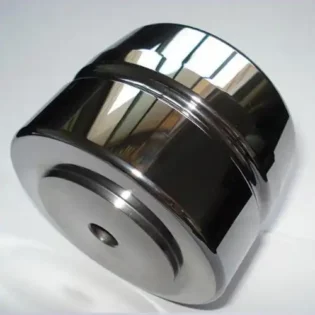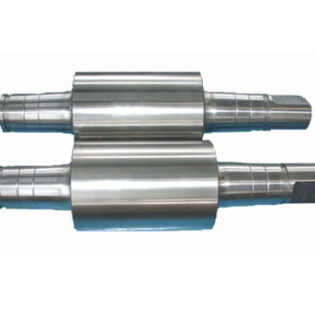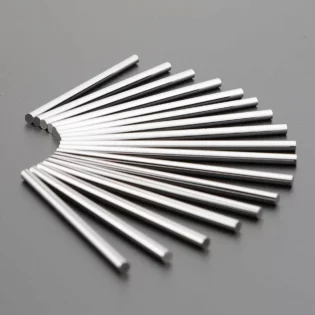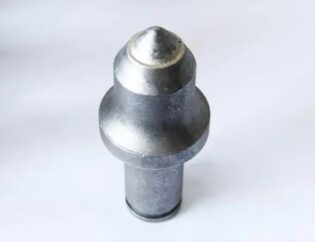Firstly, the connection method between the saw tooth insert and the saw blade body has been changed from the traditional welding method to a machine-clamping method. Secondly, the saw tooth inserts of the saw blades are coated using Chemical Vapor Deposition (CVD) technology.
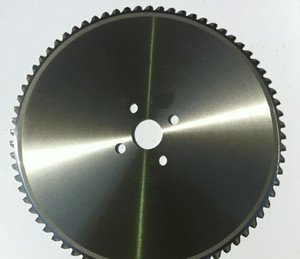
Design of Machine Clamped Carbide Toothed Circular Saw Blades
Material and Manufacturing Process of Machine Clamped Circular Saw Blades
(1) Material of Circular Saw Blade Body
The material selected for the machine clamped coated carbide toothed circular saw blade body is 75Cr1, with a material hardness of 35HRC. 75Cr1 is a specialized steel for saw blades, with a carbon content of 0.70%-0.80%. Due to its higher carbon content and the addition of Cr elements, 75Cr1 can obtain high hardness and strength after heat treatment, and its impact resistance is significantly improved. It is widely used in carbide saw blade substrates and diamond saw blade substrates.
(2) Material of Saw Blade Saw Tooth Insert
The insert material uses ultra-fine grain carbide with a grade number of P25-P40 series. The WC grain size of ultra-fine grain carbide is below 0.5μm, which is a fraction to several fractions of the WC grain size of ordinary carbide. After grain refinement, the hardness, wear resistance, bending strength, and chipping resistance of the alloy are significantly improved. It is widely used in the processing of difficult-to-machine metal materials such as stainless steel, hardened steel, and chilled cast iron. P-type ultra-fine grain carbide is particularly good at processing long chip-producing black metals (such as stainless steel). Its lifespan is 3-10 times higher than that of ordinary carbide.
(3) Manufacturing Process of Machine Clamped Circular Saw Blades
The processing of the machine clamped saw blade body involves laser cutting for blanking, followed by heat treatment, flattening, grinding of the inner hole and surface, and other machining processes. The processing of the blade body is completed through the detection of hard indicators such as end runout, diameter runout, and flatness.
The tooth seat structure model of the saw blade body is shown in Figure 1. The processing of the machine clamped saw blade body tooth seat structure involves milling the tooth seat, milling the semi-circular groove, drilling the fastening holes, tapping threads based on the fastening holes, and other processes, and the end runout of the tooth seat is detected and checked to complete the processing.
Geometric Parameters of Machine Clamped Circular Saw Blades
(1) Geometric Parameters of the Machine Clamped Circular Saw Blade Body
The diameter of the machine clamped circular saw blade body is 965mm, with a thickness of 9mm. The surface roughness of the saw blade is R≤3.2μm, and the end runout is ultimately guaranteed to be within 0.07mm.
In the tooth seat structure of the machine clamped circular saw blade body, the width of the semi-circular positioning groove is 6-8mm, the depth is 0.4-0.6mm, and the clamping screw selected is M4×12mm.
(2) Geometric Parameters of the Machine Clamped Saw Tooth Insert
The machine clamped saw tooth insert is a non-standard insert, and its geometric structure requires independent research and development design. Based on the thickness of the saw blade body and the tooth seat structure, the insert’s thickness, width, and height are designed to be 15mm, 10mm, and 6mm, respectively. The model schematic of the machine clamped insert is shown in Figure 2. The clamping part is designed with a countersunk screw connection. The specific structural geometric parameters are as follows:
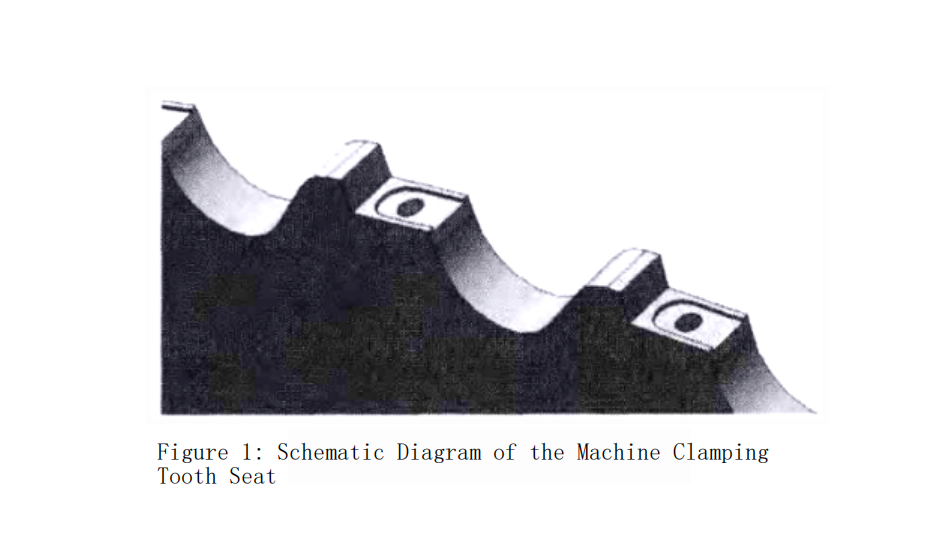
Front Relief Angle: The sawing process is a discontinuous cutting operation, during which the insert will continuously receive impacts. Considering the brittleness of the carbide tool material, the front relief angle should not be too large. Therefore, based on past sawing experience, the front relief angle of the saw tooth insert is chosen to be 6°-8°, as shown in Figure 3.
Rear Relief Angle: A rear relief angle that is too large will lead to a decrease in the insert’s ability to withstand impacts. Therefore, considering the above factors and sawing experience, the rear relief angle of the insert is selected to be 8°-12°, as shown in Figure 3.
Negative Chamfer: A negative chamfer needs to be ground on the front cutting edge. The chamfer can not only further enhance the strength of the insert’s cutting edge but also increase the insert’s wedge angle to improve heat dissipation conditions. Based on relevant theoretical research and sawing experience, the negative chamfer width is chosen to be 0.3-0.5mm, with a chamfer angle of 14°-18°, as shown in Figure 3.
Chip Groove: Chip grooves can be divided into three shapes: rectangular, angular, and circular arc. The machine clamped saw tooth insert will use a circular arc-shaped chip groove. The groove width and depth are 0.2-0.4mm, with a circular arc radius of 0.3-0.5mm. The chip grooves between adjacent teeth are symmetrically distributed. The chip grooves on the saw tooth insert are shown in Figure 2.

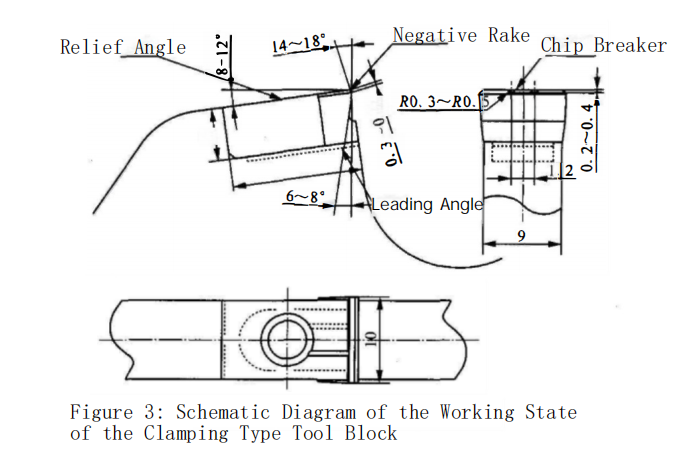
Coating Materials and Parameters for Saw Tooth Inserts
Based on the theory of coating technology and the actual sawing conditions, the saw tooth inserts will be coated using CVD technology with TiAlN and AlCrN coatings for comparative testing. The characteristics of the two coating materials are as follows:
TiAlN Coating: This is a widely used coating material with a hardness of 3400-3600HV and an oxidation resistance temperature up to 800°C. During cutting, it can oxidize to form Al?O?, thus creating a hard, inert protective film that serves as an antioxidant and resistant to diffusion wear. It is the preferred coating for processing difficult-to-cut metal materials such as high-alloy steel, stainless steel, and titanium alloys.
AlCrN Coating: This is another new type of coating material developed after TiAlN. Its unique cubic crystal lattice structure endows it with high red hardness and wear resistance, with a hardness of 2800-3200HV. It can maintain high hardness at temperatures up to 1100°C. Its toughness is superior to TiAlN, making it more suitable for intermittent cutting. It is applicable to various cemented carbide tools, including gear hobbing cutters and end mills, especially when cutting stainless steel, it exhibits good chip breaking performance.
The finished machine clamped saw blade is shown in Figure 4.
Performance Testing of Coated Cemented Carbide Toothed Circular Saw Blades
Test Conditions and Methods
The coating performance test sawing experiment was conducted in a sawing workshop at a certain steel pipe factory. The sawing machine used in this test was produced by Wagner, model WHC1000. The workpiece to be sawed was solid round steel, with a material composition of 13Cr (stainless steel) and a diameter of φ270mm. The saw tooth inserts to be used included uncoated inserts and inserts coated with TiAlN and AlCrN vapor deposition coatings, both with a coating thickness of 4-5μm, which is a conventional thickness for coatings.
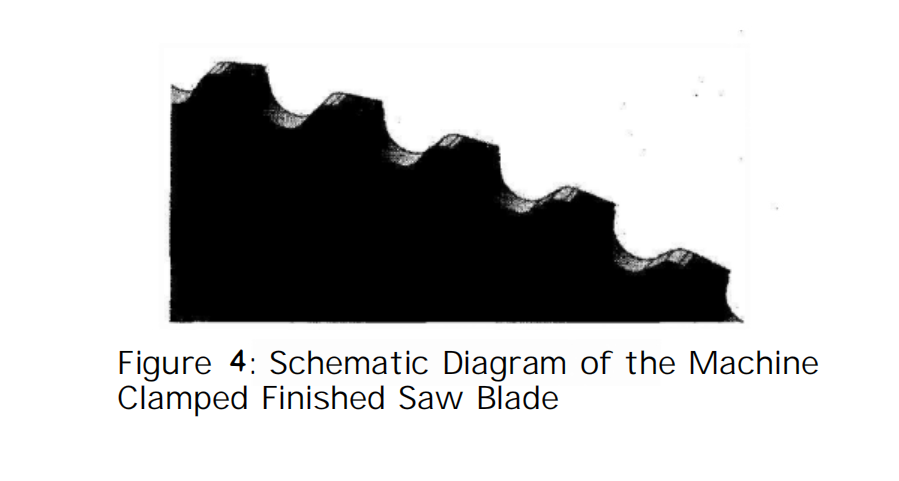
Sawing Test Process
First, the uncoated welded carbide toothed circular saw blade was mounted for testing. During the trial cut, it was found that the sawing machine consumed a high amount of power. After 5 cutting cycles, the machine was stopped, and it was observed that the insert cutting edge had already shown signs of wear. After adjusting the sawing parameters, the test continued. During the process, the sound of the saw entering the material gradually increased, and after more than 20 cutting cycles, sparks appeared at the cutting area with red chips flying out, and the sawing machine vibrated significantly. After 30 cutting cycles, the machine was stopped for observation, and it was found that the saw blade cutting edge was significantly worn, with severe edge chipping. The cross-section of the workpiece had a large number of burrs. Since the saw blade was scrapped, the test was immediately stopped.
Next, the TiAlN coated carbide toothed circular saw blade was installed on the sawing machine and no abnormalities were found during the trial cut. After adjusting the parameters, the cutting continued until more than 80 cutting cycles, when it was observed that the power consumption of the sawing machine had increased. After the 90th cutting cycle, the machine was stopped for inspection, and it was found that there were a few built-up edges at the insert cutting edge, and three saw tooth inserts had?slightly?chipping.
Finally, the AlCrN coated carbide toothed circular saw blade was installed. After the trial cut phase, the machine was stopped for observation, and the saw blade was found to be in good condition with no abnormalities. After adjusting the sawing parameters to the normal range and continuing the observation, the sawing process was smooth, with no abnormal changes in sound or chip ejection. After more than 130 cutting cycles, the cutting sound slightly increased, and the sawing machine showed slight vibration. After 140 cutting cycles, the machine was stopped, and the blade was removed for a detailed inspection. It was found that there were a few built-up edges, but all insert blocks showed normal wear with no chipping. The surface roughness of the workpiece cross-section was low, meeting the precision requirements.
Test Results and Discussion
The test conditions for the three types of saw blades are shown in Table 1.

Based on the analysis of Table 1, it is understood that the tool coating can significantly improve the cutting performance of carbide toothed circular saw blades, and the service life of the saw blades is extended to 3-5 times that of traditional uncoated welded saw blades. A comparison of the two coating materials found that AlCrN coating has superior performance compared to TiAlN coating.
(1) Compared to uncoated circular saw blades, coated circular saw blades demonstrate superior cutting performance, mainly because the coating material has good comprehensive properties. This is mainly manifested in the following aspects:
The hardness of the coating is about twice that of the carbide material used for the saw tooth inserts, which reduces the frictional wear and adhesive wear between the saw tooth inserts and the workpiece being cut, and improves the wear resistance of the saw tooth inserts; the inert Al?O? film generated by the coating material during the sawing process can enhance the oxidation resistance of the saw tooth inserts; the low friction coefficient between the coating material and metal can reduce the cutting force and cutting temperature, thereby greatly improving the durability of the tool; the low thermal diffusivity of the coating material can slow down the rate at which cutting heat diffuses to the carbide substrate of the saw tooth insert, thereby reducing the thermal load on the insert substrate, which is particularly important during intermittent cutting processes.
(2) Through the comparison of sawing tests with the two coating materials, it was found that AlCrN coating is more suitable for sawing stainless steel than TiAlN coating. Therefore, an analysis of the properties of the two coating materials was conducted: According to the metal lattice theory, the lattice structure of AlCrN is superior to that of TiAlN in its ability to solid-solve Al, so the AlCrN coating will generate more Al?O? during the cutting process, and the formed Al?O? film is more stable. Moreover, Cr has a higher melting point than Ti, therefore, the AlCrN coating with Cr substituting for Ti has significantly improved resistance to high temperatures and oxidation compared to the TiAlN coating, with a smaller friction coefficient and stronger chip evacuation capability. Although the hardness is slightly reduced, the comprehensive performance is more excellent.
Вывод
Through the comparison and analysis of the cutting performance tests of uncoated, TiAlN, and AlCrN coated carbide toothed circular saw blades, the following conclusions are drawn:
(1) Coated carbide toothed circular saw blades significantly improve the cutting ability and extend the service life of the saw blades.
(2) Coating material: Based on theoretical analysis and test results, the novel AlCrN coating can be preferentially selected.

